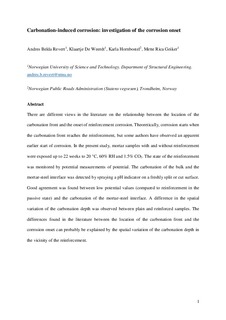| dc.contributor.author | Revert, Andres Belda | |
| dc.contributor.author | De Weerdt, Klaartje | |
| dc.contributor.author | Hornbostel, Karla | |
| dc.contributor.author | Geiker, Mette Rica | |
| dc.date.accessioned | 2019-02-18T13:41:34Z | |
| dc.date.available | 2019-02-18T13:41:34Z | |
| dc.date.created | 2017-12-15T11:28:45Z | |
| dc.date.issued | 2018 | |
| dc.identifier.citation | Construction and Building Materials. 2018, 162 847-856. | nb_NO |
| dc.identifier.issn | 0950-0618 | |
| dc.identifier.uri | http://hdl.handle.net/11250/2586003 | |
| dc.description.abstract | There are different views in the literature on the relationship between the location of the carbonation front and the onset of reinforcement corrosion. Theoretically, corrosion starts when the carbonation front reaches the reinforcement, but some authors have observed an apparent earlier start of corrosion. In the present study, mortar samples with and without reinforcement were exposed for up to 22 weeks to 20 °C, 60% RH and 1.5% CO2. The state of the reinforcement was monitored by potential measurements. The carbonation of the bulk and the mortar-steel interface was detected by spraying a pH indicator on a freshly split or cut surface. Good agreement was found between low potential values (compared to reinforcement in the passive state) and the carbonation of the mortar-steel interface. A difference in the spatial variation of the carbonation depth was observed between plain and reinforced samples. The differences found in the literature between the location of the carbonation front and the corrosion onset can probably be explained by the spatial variation of the carbonation depth in the vicinity of the reinforcement. | nb_NO |
| dc.language.iso | eng | nb_NO |
| dc.publisher | Elsevier | nb_NO |
| dc.rights | Attribution-NonCommercial-NoDerivatives 4.0 Internasjonal | * |
| dc.rights.uri | http://creativecommons.org/licenses/by-nc-nd/4.0/deed.no | * |
| dc.title | Carbonation-induced corrosion: Investigation of the corrosion onset | nb_NO |
| dc.title.alternative | Carbonation-induced corrosion: Investigation of the corrosion onset | nb_NO |
| dc.type | Journal article | nb_NO |
| dc.type | Peer reviewed | nb_NO |
| dc.description.version | acceptedVersion | nb_NO |
| dc.source.pagenumber | 847-856 | nb_NO |
| dc.source.volume | 162 | nb_NO |
| dc.source.journal | Construction and Building Materials | nb_NO |
| dc.identifier.doi | 10.1016/j.conbuildmat.2017.12.066 | |
| dc.identifier.cristin | 1527922 | |
| dc.description.localcode | © 2017. This is the authors’ accepted and refereed manuscript to the article. Locked until 15.12.2019 due to copyright restrictions. This manuscript version is made available under the CC-BY-NC-ND 4.0 license http://creativecommons.org/licenses/by-nc-nd/4.0/ | nb_NO |
| cristin.unitcode | 194,64,45,0 | |
| cristin.unitname | Institutt for konstruksjonsteknikk | |
| cristin.ispublished | true | |
| cristin.fulltext | preprint | |
| cristin.qualitycode | 2 | |

